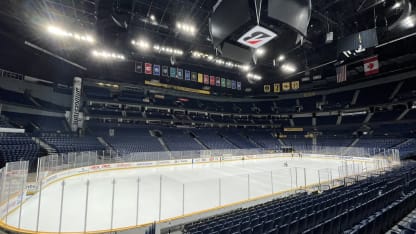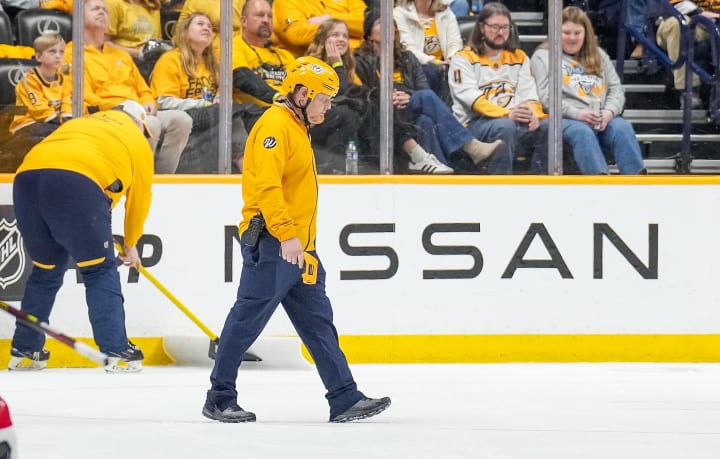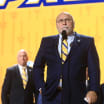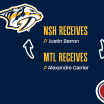Of course, heading up the all-important job is Senior Director of Ice Operations Nigel Schnarr, who’s entering his 11th campaign with the Predators this season. With years of experience and the fascinating insider’s knowledge that comes with it, we asked Schnarr some of your most frequently asked questions about the days-long process, covering everything from the temperature of the ice to the enormous amount of water used along the way.
Let’s get right into it:
What is the step-by-step process to making the ice at Bridgestone Arena?
“We start with a concrete slab, and yesterday we started freezing that down. It was about 70 degrees Fahrenheit yesterday at about 1:00 in the afternoon, and by this morning, we got it down to about 16 degrees. So today, we’ll seal in that concrete slab. I did kind of like a fire hose flood on it, and then we'll come out with white paint and we'll put three to four coats of white paint down so everything is covered in white and you don't see any of the concrete. And then we'll seal it in with about five coats of white, plain water. Once we're done with that, we'll go out and mark all the blue lines, red lines, face-off circles, hash marks, goal creases and then paint those. All those get painted by hand, and then once those are done, we'll start to lay our logos in the neutral zone, the four corners. And then usually the last thing we do is put the Pred Head in at center ice.”
What are some unique challenges that come with maintaining ice in Nashville, Tennessee?
“The biggest challenge is the weather outside. If it's humid, it really does play a factor on how fast we can get that water to freeze. There's some times where we've had to sit and wait for it to freeze and it's just not freezing fast enough, and that's usually a product of there being too much moisture in the air.”
How cold does the building need to be to keep the ice frozen?
“We can fluctuate the air in the building because all the heat is being pulled out from underneath the ice. So once we put the floor on top of it for a concert or an event, it's insulated and it'll maintain a 24-degree surface temperature on the ice. And then once that's uncovered, we can pull it down a little bit more. So, we can fluctuate a little bit, but we usually try not to go over 70 degrees when it's covered, and usually don't go over about 62-63 degrees when it’s uncovered.”
How cold is the ice?
“For games, usually we're running air temp around 56 degrees Fahrenheit and then the surface temps may be around 19 degrees, which is a little brittle. If you get it too cold, it can get a little brittle out there. So if you get a hard cut, something like that, your ice has a chance to chip out. So you try to kind of warm it up, and that usually helps. And then we'll put a heat load on it when we do the resurfacing after warm ups, and then by the time puck drop comes, you're right in that 22-degree, 22-and-a-half degree surface temp where you need to be. If you get it too warm, like 24-25 degrees, then the players are going to feel like they're kind of sinking into the ice.”
Do you take feedback from the players into account during the season?
“I usually try to check in with them, but I live by the no news is good news mantra. So if they're not saying anything, and I see that the ice looks good, it's skating well - that kind of thing - I'm just going to stick with what I'm doing. Then when they start to say, ‘Hey man, it's a little slow, a little sluggish, we’ve got a lot of snow on the ice,’ then I usually say, ‘OK, I'm going to run it a little bit colder.’ But you also have to look into the fact that if it's a hot, humid day outside and you're playing a game, it's going to generate a lot of snow as well, and then that snow is going to get sticky and it's almost going to freeze to the ice. So by the end of the period, you try to make a long pass up the middle, it may start bouncing on you, because that snow is just stuck, and that's mainly what they're going to mention. I'd say the majority of the time it’s just pucks bouncing over the ice that’s the main issue.”
How many gallons of water does it take to create the ice?
“I don’t know the exact figure, but I know that it takes well over 20,000 gallons of water.”
How much paint does it take?
“We use these one-gallon boxes of paint, and we go through 10 of those, so almost 10 gallons of white powder mixed with a ratio that's about a 150-gallon water tank. And usually we’re using three to three and a half or four coats of that.”
How do you get the lines painted on perfectly straight and the faceoff circles perfectly round?
“Some of them are hand painted, and then we also have what's called a paint stick. So you have a gallon of paint resting on your shoulder in a bag. And then there's a stick that goes down to a sponge that’s about two inches wide, so the width of the goal lines or the hash marks. And then you can kind of control the flow of your paint. We'll take a string and kind of map out your lines in a straight line. With the circles, there's a cable. So, one guy stands in the middle where the face-off dot is, and the cable goes out about 15 feet, and he just keeps it taut and walks around in a circle. And so you end up with a perfect two-inch circle or straight line.”
How many people work on the ice year-round?
“I've got two full time guys that work with me all year long here at Bridgestone Arena, and then our director of building operations is also trained as a certified ice tech as well, so he does help out. Then I've got a crew on game day, usually 12-14 people. About 11 of them will skate during the TV timeouts to clear off the snow. And then, obviously, we’ve got our two Zamboni drivers.”




















